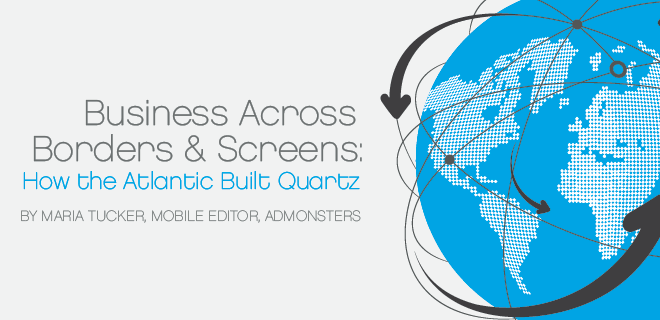
“The world is getting smaller and more global, and more companies from small to large are doing business across borders,” says Jay Lauf, Publisher of The Atlantic’s new mobile-specific news site Quartz. “Global business professionals, almost by definition, are very mobile, very tech savvy, and very connected. They need things to be always on as they cross time zones.”
As the world’s attention becomes increasingly divided, traditional publishers have learned to follow their audiences across multiple screens. However, the multiscreen approach was quite apt for Atlantic Media Company as it sought to nourish a growing audience segment – global business professionals juggling multiple devices.
“At Atlantic Media Company, we look at spaces adjacent to our properties that don’t do exactly the same thing,” Lauf explains. “As we surveyed our market, we saw one demographic growing in both numbers and importance: global business professionals. So, we came up with a product to serve that market and to serve it in a way that is reflective of their own habits and the devices they have closest at hand.”
Thus, Quartz’s content is carefully curated to satiate global business professionals’ appetites for relevant news – one day’s top stories cover Facebook profits and India’s “gold mania” – delivered 24 hours a day across every time zone.
Due to the rapid pace of tablet adoption and the medium’s suitability for displaying long-form content, Quartz was designed first for tablets, then smartphones and finally desktop. Marketed as a “digitally native news outlet for the global economy,” the publication bypasses the app economy by relying on a single site optimized by responsive design, allowing the displayed content to transition almost seamlessly from tablets to smartphones to desktop
The site reached 3.1 million unique visitors in aggregate in 2012, and in December alone topped 1.4 million. “We are way ahead of our original pacing schedule and have tripled our expectations for 2012,” Lauf says.
Because of Quartz’s focused audience (very smart, very affluent, very influential), each of these viewers represents a valuable target for advertisers, and Quartz has worked to ensure that the advertisements on its site – all premium – are embedded within the content stream, designed to be synchronous with editorial content.

Quartz’s ability to streamline advertising and content begins in the environment in which it is published. Quartz is headquartered in an open loft space in SoHo. Lauf says, “That alone fosters a certain level of camaraderie and collaboration: editors, developers, sales and marketing people. We share a sense of mission and purpose.”
While there is an “absolutely sacrosanct” divide between editorial and advertising content, the Quartz team attempts to look holistically at technology and development, viewing both types of content as the whole product experience.
Lauf reveals that the editorial and advertising teams at Quartz do share some of the developers. “While there are some developers whose primary job it is to work on user interface, some are really dedicated to editorial experience, and I do have content and developers on my team who work for advertisers. We in sales and marketing are building out a team that mirrors the editorial team in service of the advertising.”
Advertising and editorial content do come together beautifully on Quartz, which features two main types of advertising: engage and bulletin. Engage ad units are over-sized ad units with enhanced capabilities, including rich media and video.
Bulletin ad units are responsive ad units that are written by Quartz’s marketing team and that are designed to mimic its editorial content. These ad units have the same functionality as any editorial content and can include infographics, live links, sharing (social), and video. For instance, the site currently features a bulletin piece on deep sea exploration sponsored by Cadillac. An unlikely pairing, to be sure, but the article is something that Quartz’s users would actually read.

Lauf reports that so far both consumer and advertiser feedback for Quartz has been great. “There are always development challenges when you launch a new digital product, especially one with new technologies (HTML5, CSS3),” he says. “But we feel as though the challenges relative to what they could be have been few.”
The Quartz team is constantly trying to improve the user experience and intends to make it faster, sleeker and more responsive. They’ve also found that the site does not work well on old versions of browsers versions such as IE6.
Addressing this, Lauf paraphrases Roger McNamee, co-founder of Elevation Partners, “Every dollar, every man hour, every bit of intellectual energy that you spend to retrofit to old technologies is a dollar, a man hour, a bit of intellectual energy that you aren’t spending on the future.”